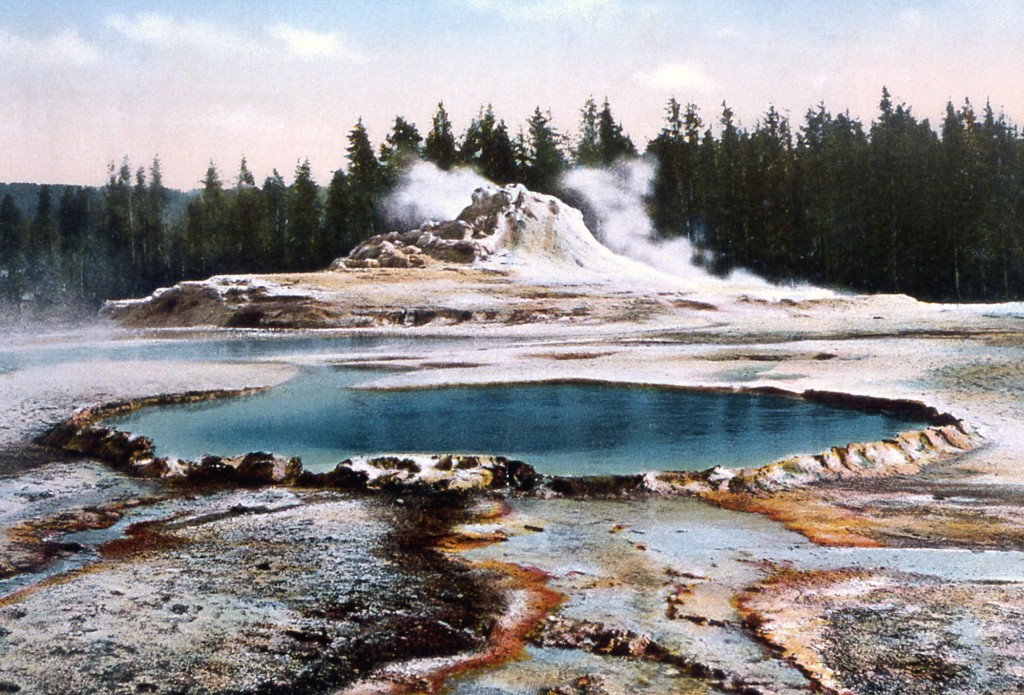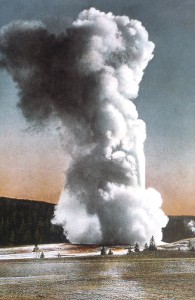Writing Sound: Listening to Muir on Yellowstone’s Birthday

 Postcard of Old Faithful Geyser; Frank J Haynes
Postcard of Old Faithful Geyser; Frank J Haynes
On the 144th anniversary of the establishment of Yellowstone National Park, I happened upon John Muir’s 1898 entry in The Atlantic Monthly, “The Yellowstone National Park.” Always on the lookout for descriptions of sound, I found a treasure of references to the auditory experience of our first national park.
Muir’s words are as a sermon, inviting a flock of travelers both in body and in imagination to lie down in the “stimulating, quickening pasturage” of the “blessed old Yellowstone Wonderland.” And as voice is inseparable from the idea of a preacher, so too does Muir evoke the awesome voice of a tumultuous and vibrant landscape:
A thousand Yellowstone wonders are calling, “Look up and down and round about you!” And a multitude of still, small voices may be heard directing you to look through all this transient, shifting show of things called “substantial” into the truly substantial, spiritual world whose forms flesh and wood, rock and water, air and sunshine, only veil and conceal, and to learn that here is heaven and the dwelling-place of the angels.
To me, what is striking in this passage is the use of comparative volume to encompass all that Yellowstone invites us to contemplate. The thousands of exclamatory calls bring to mind the breathtaking and frankly terrifying geology of the park. Indeed, Muir’s descriptions of Yellowstone’s geothermal wonders seem to emphasize their awesomeness:
However orderly your excursions or aimless, again and again amid the calmest, stillest scenery you will be brought to a standstill hushed and awe-stricken before phenomena wholly new to you. Boiling springs and huge deep pools of purest green and azure water, thousands of them, are splashing and heaving in these high, cool mountains as if a fierce furnace fire were burning beneath each one of them; and a hundred geysers, white torrents of boiling water and steam, like inverted waterfalls, are ever and anon rushing up out of the hot, black underworld. Some of these ponderous geyser columns are as large as sequoias,—five to sixty feel in diameter, one hundred and fifty to three hundred feet high,—and are sustained at this great height with tremendous energy for a few minutes, or perhaps nearly an hour, standing rigid and erect, hissing, throbbing, booming, as if thunderstorms were raging beneath their roots, their sides roughened or fluted like the furrowed boles of trees, their tops dissolving in feathery branches, while the irised spray, like misty bloom is at times blown aside, revealing the massive shafts shining against a background of pine-covered hills.
Let’s listen Beehive Geyser as it builds to that “hissing, throbbing, booming, as if thunderstorms were raging beneath [its] roots”
Click Here to Listen
In another passage, Muir imagines Yellowstone’s cauldrons and mudpots as science experiments in a vast natural laboratory, with “Nature at work as a chemist…cunningly compounding an infinite variety of mineral messes.” Listen, for example, to the “gasping, belching, thudding sounds” of a boiling mud pot, as in this recording of Fountain Paint Pots:
Click Here to Listen
Muir reminds us that the deafening noise of Yellowstone’s wonders serve to quiet us:
there is a chatter of small talk in anything but solemn mood; and during the intervals between the preliminary splashes and upheavals some adventurer occasionally looks down the throat of the crater, admiring the silex formations and wondering whether Hades is as beautiful. But when, with awful uproar as if avalanches were falling and storms thundering in the depths, the tremendous outburst begins, all run away to a safe distance, and look on, awe-stricken and silent, in devout, worshiping wonder.
He employs sound to write the mood of a place that requires “stout faith to feel at ease“:
The ground sounds hollow underfoot, and the awful subterranean thunder shakes one’s mind as the ground is shaken, especially at night in the pale moonlight, or when the sky is overcast with storm-clouds. In the solemn gloom, the geysers, dimly visible, look like monstrous dancing ghosts, and their wild songs and the earthquake thunder replying to the storms overhead seem doubly terrible, as if divine government were at an end.
I have marveled at my being in the world amidst growling thunder. I have thanked a howling wind that my ego could not stand to face. The ferocity of nature is so often marked by sound: a roaring, rushing, thundering, crashing, thudding, rumbling beat of a wild heart. It’s enough to give one’s own heart pause – and then to resume, realigned to the faith of the world:
But the trembling hills keep their places. The sky clears, the rosy dawn is reassuring, and up comes the sun like a god, pouring his faithful beams across the mountains and forest, lighting each peak and tree and ghastly geyser alike, and shining into the eyes of the reeking springs, clothing them with rainbow light, and dissolving the seeming chaos of darkness into varied forms of harmony. The ordinary work of the world goes on. Gladly we see the flies dancing in the sun-beams, birds feeding their young, squirrels gathering nuts, and hear the blessed ouzel singing confidingly in the shallows of the river,—most faithful evangel, calming every fear, reducing everything to love.
You can take an audio tour of the “blessed old Yellowstone Wonderland” via the Acoustic Atlas Yellowstone National Park Collection and Yellowstone National Park’s Sound Library.
“Beehive Geyser, compilation” recorded by Peter Comely and “Mud pots, Fountain Paint Pots” recorded by Jennifer Jerrett are public domain audio files. “Rain and thunder, Grand Teton National Park” audio file courtesy of the National Park Service. “American Dipper song” audio files copyright 2014, Kevin Colver, all rights reserved.
Photo credit: “Postcard of Crested Pool & Castle Geyser” and “Postcard of Old Faithful Geyser” by Frank J. Haynes / NPS.
